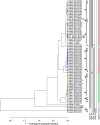Molecular epidemiology, microbiological features and infection control strategies for carbapenem-resistant Acinetobacter baumannii in a German burn and plastic surgery center (2020-2022)
- PMID: 39242542
- PMCID: PMC11378564
- DOI: 10.1186/s13756-024-01459-5
Molecular epidemiology, microbiological features and infection control strategies for carbapenem-resistant Acinetobacter baumannii in a German burn and plastic surgery center (2020-2022)
Abstract
Background: Carbapenem-resistant Acinetobacter baumannii (CRAB) frequently causes both healthcare-associated infections and nosocomial outbreaks in burn medicine/plastic surgery and beyond. Owing to the high antibiotic resistance, infections are difficult to treat, and patient outcomes are often compromised. The environmental persistence capability of CRAB favors its transmission in hospitals. A comprehensive analysis and understanding of CRAB epidemiology and microbiology are essential for guiding management.
Methods: A three-year retrospective cohort study (2020-2022) was conducted in a German tertiary burn and plastic surgery center. In addition to epidemiological analyses, microbiological and molecular techniques, including whole-genome sequencing, were applied for the comprehensive examination of isolates from CRAB-positive patients.
Results: During the study period, eight CRAB cases were found, corresponding to an overall incidence of 0.2 CRAB cases per 100 cases and an incidence density of 0.35 CRAB cases per 1000 patient-days. Six cases (75%) were treated in the burn intensive care unit, and four cases (50%) acquired CRAB in the hospital. Molecular analyses comprising 74 isolates supported the epidemiologic assumption that hospital acquisitions occurred within two separate clusters. In one of these clusters, environmental CRAB contamination of anesthesia equipment may have enabled transmission. Furthermore, molecular diversity of CRAB isolates within patients was observed.
Conclusions: CRAB can pose a challenge in terms of infection prevention and control, especially if cases are clustered in time and space on a ward. Our study demonstrates that high-resolution phylogenetic analysis of several bacterial isolates from single patients can greatly aid in understanding transmission chains and helps to take precision control measures.
Keywords: Acinetobacter baumannii; Carbapenem; Epidemiology; Infection prevention and control; Microbiology; Resistance; Whole-genome sequencing.
© 2024. The Author(s).
Conflict of interest statement
The authors declare no competing interests.
Figures



Similar articles
-
Phenotypic and molecular characterization of Acinetobacter baumannii isolates causing lower respiratory infections among ICU patients.Microb Pathog. 2019 Mar;128:75-81. doi: 10.1016/j.micpath.2018.12.023. Epub 2018 Dec 15. Microb Pathog. 2019. PMID: 30562602
-
Environmental contamination with carbapenem resistant Acinetobacter baumannii in healthcare settings in Fiji: a potential source of infection.Front Cell Infect Microbiol. 2024 Sep 23;14:1429443. doi: 10.3389/fcimb.2024.1429443. eCollection 2024. Front Cell Infect Microbiol. 2024. PMID: 39376664 Free PMC article.
-
One-year molecular surveillance of carbapenem-susceptible A. baumannii on a German intensive care unit: diversity or clonality.Antimicrob Resist Infect Control. 2018 Nov 26;7:145. doi: 10.1186/s13756-018-0436-8. eCollection 2018. Antimicrob Resist Infect Control. 2018. PMID: 30505434 Free PMC article.
-
The incidence and prevalence of hospital-acquired (carbapenem-resistant) Acinetobacter baumannii in Europe, Eastern Mediterranean and Africa: a systematic review and meta-analysis.Emerg Microbes Infect. 2019;8(1):1747-1759. doi: 10.1080/22221751.2019.1698273. Emerg Microbes Infect. 2019. PMID: 31805829 Free PMC article.
-
Molecular epidemiology of carbapenem-resistant Acinetobacter baumannii in Greece: an extended review (2000-2015).Future Microbiol. 2017 Jul;12:801-815. doi: 10.2217/fmb-2016-0200. Epub 2017 Jun 12. Future Microbiol. 2017. PMID: 28604100 Review.
References
-
- Ng DHL, Marimuthu K, Lee JJ, Khong WX, Ng OT, Zhang W, et al. Environmental colonization and onward clonal transmission of carbapenem-resistant Acinetobacter baumannii (CRAB) in a medical intensive care unit: the case for environmental hygiene. Antimicrob Resist Infect Control. 2018;7:51. 10.1186/s13756-018-0343-z. 10.1186/s13756-018-0343-z - DOI - PMC - PubMed
-
- Ben-Chetrit E, Wiener-Well Y, Lesho E, Kopuit P, Broyer C, Bier L, et al. An intervention to control an ICU outbreak of carbapenem-resistant Acinetobacter baumannii: long-term impact for the ICU and hospital. Crit Care. 2018;22:319. 10.1186/s13054-018-2247-y. 10.1186/s13054-018-2247-y - DOI - PMC - PubMed
MeSH terms
Substances
LinkOut - more resources
Full Text Sources
Medical

